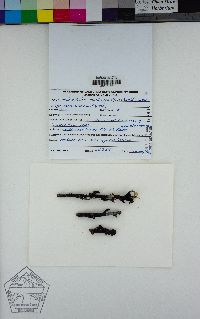
Consortium of Lichen Herbaria
- building a Global Consortium of Bryophytes and Lichens as keystones of cryptobiotic communities -
- Home
- Search
- Images
- Species Checklists
- US States: O-Z >
- US National Parks
- Central America
- South America
- US National Parks
- Southern Subpolar Region
|
|
|
|
Family: Parmeliaceae
[Melanelia multispora (A. Schneider) Essl., moreParmelia multispora A. Schneid.] |
Nash, T.H., Ryan, B.D., Gries, C., Bungartz, F., (eds.) 2002. Lichen Flora of the Greater Sonoran Desert Region. Vol 1. Thallus: adnate to loosely adnate appressed or somewhat raised at the periphery, foliose, up to 7 cm diam., lobate lobes: short and rounded to somewhat elongate and angular, discrete to contiguous or subimbricate, 1-3 (-4) mm broad, flat upper surface: olive-brown to dark reddish-brown, smooth to weakly rugose or pitted at the periphery, inward usually even more so, occasionally developing scattered papillae or tubercles; dull throughout or slightly shiny at the periphery; occasionally pruinose in scattered areas; usually with pseudocyphellae only on the occasional tubercles lower surface: dark brown to black, sometimes pale tan at the periphery or (rarely) throughout; smooth to distinctly rugulose or weakly traberculate; usually somewhat shiny; moderately to densely rhizinate, the rhizines ± concolorous with the lower surface Apothecia: common, up to 4 mm diam., sessile, concave to flat or somewhat convex with age, the margin entire to tuberculate, the tubercles usually pseudocyphellate asci: clavate, 12-32 (usually c. 26)-spored ascospores: subglobose to broadly ovoid or ellipsoid, 5.5-10 (-11.5) x 5-8 µm Pycnidia: common, immersed conidia: acerose to slightly fusiform, 5-8 x 1 µm Spot tests: cortex K-, C-, KC-, P-, HNO3-; medulla K-, C-, KC-, P- Secondary metabolites: none detected. Substrate: bark of shrubs or trees World distribution: west coast of North America, south-central Alaska to southern California Sonoran distribution: southern California. Notes: Based on external morphology alone, this species is not consistently distinguishable from closely related M. subolivacea. However, fertile specimens are easily identified by their 12-32 ascospores occurring in each ascus. Melanelia multispora also has a narrower distribution in western North America, and is not found in the main part of the study area. |
Powered by Symbiota













































































































